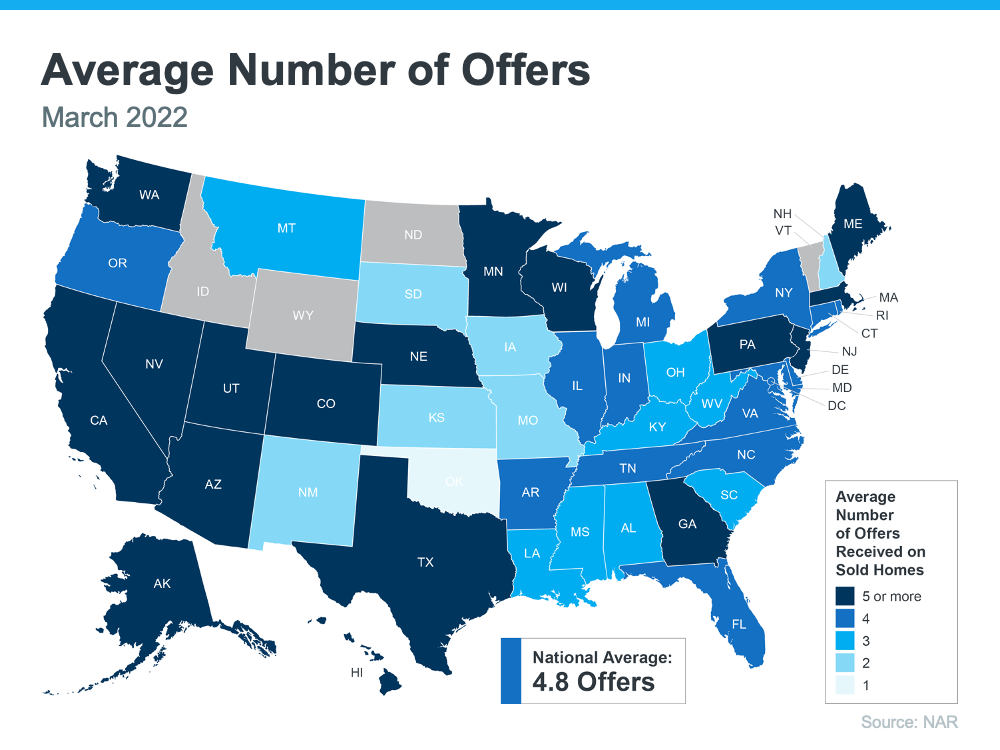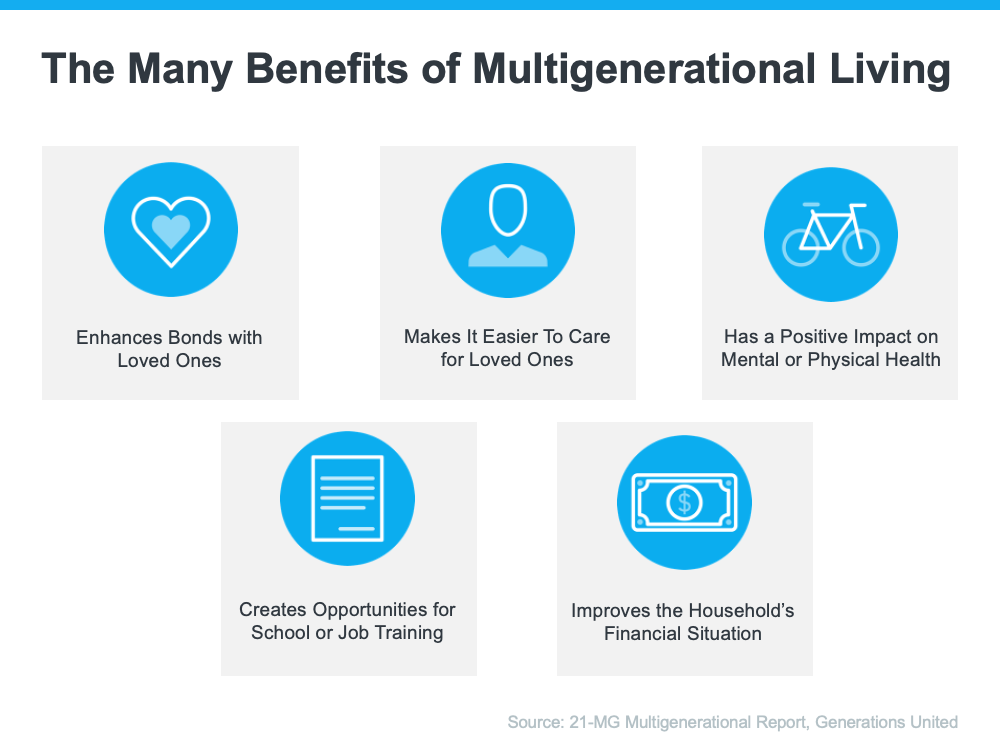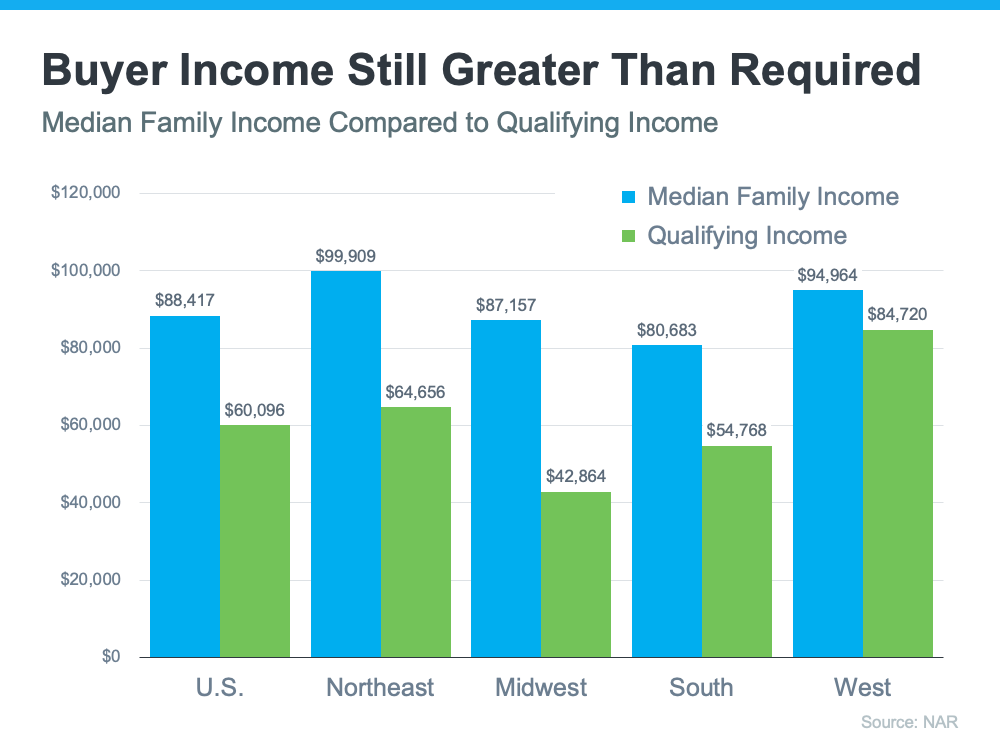With a limited number of homes for sale today and so many buyers looking to make a purchase before mortgage rates rise further, bidding wars are common. According to the latest report from the National Association of Realtors (NAR), nationwide, homes are getting an average of 4.8 offers per sale. Here’s a look at how that breaks down state-by-state (see map below):

The same report from NAR shows the average buyer made two offers before getting their third offer accepted. In this type of competitive housing market, it’s important to know what levers you can pull to help you beat the competition. While a real estate professional is your ultimate guide to presenting a strong offer, here are a few things you could consider.
Offering over Asking Price
When you think of sweetening the deal for sellers, the first thought you likely have is around the price of the home. In today’s housing market, it’s true more homes are selling for over asking price because there are more buyers than there are homes for sale. You just want to make sure your offer is still within your budget and realistic for the market value in your area – that’s where a local real estate professional can help you through the process. Bankrate says:
“Simply put, being willing to pay more money than other buyers is one of the best ways to get your offer accepted. You may not have to increase it by a lot — it’ll depend on the area and other factors — so look to your real estate agent for guidance.”
Putting Down a Bigger Earnest Money Deposit
You could also consider putting down a larger deposit up front. An earnest money deposit is a check you write to go along with your offer. If your offer is accepted, this deposit is credited toward your home purchase. NerdWallet explains how it works:
“A typical earnest money deposit is 1% to 2% of the home’s purchase price, but the amount varies by location. A higher earnest money deposit may catch a seller’s attention in a hot housing market.”
That’s because it shows the seller you’re seriously interested in their house and have already set aside money that you’re ready to put toward the purchase. Talk to a professional to see if this is something you can do in your area.
Making a Higher Down Payment
Another option is increasing how much of a down payment you’re going to make. The benefit of a higher down payment is you won’t have to finance as much. This helps the seller feel like there’s less risk of the deal or the financing falling through. And if other buyers put less down, it could be what helps your offer stand out from the crowd.
Non-Financial Options To Make a Strong Offer
Realtor.com points out that while increasing these financial portions of the deal can help, they’re not your only options:
“. . . Price is not the only factor sellers weigh when they look at offers. The buyer’s terms and contingencies are also taken into account, as well as pre-approval letters, appraisal requirements, and the closing time the buyer is asking for.”
When it’s time to make an offer, partner with a trusted professional. They have insight into what sellers are looking for in your local market and can give you expert advice on what levers you may or may not want to pull when it’s time to write an offer.
From a non-financial perspective, this can include things like flexible move-in dates or minimal contingencies (conditions you set that the seller must meet for the purchase to be finalized). For example, you could make an offer that’s not contingent on the sale of your current home. Just remember, there are certain contingencies you don’t want to forego, like your home inspection. Ultimately, the options you have can vary state-to-state, so it’s best to lean on an expert real estate professional for guidance.
Bottom Line
In today’s hot housing market, you need a partner who can serve as your guide, especially when it comes to making a strong offer. Let’s connect so you have a trusted resource and coach on how to make the strongest offer possible for your specific situation.
💡 Find out if we’re the right Realtor Team for you! We’re active in our community…check out @carealestategroup
👩 Christine Almarines @christine_almarines
Realtor DRE # 01412944
714-476-4637 | christine@carealestategroup.com
👩 Michelle Kim @michellejeankim_homes
Realtor DRE # 01885912
714-253-7531 | michelle@carealestategroup.com
CA Real Estate Group is powered by Keller Williams Realty
The information contained, and the opinions expressed, in this article are not intended to be construed as investment advice. Keeping Current Matters, Inc. does not guarantee or warrant the accuracy or completeness of the information or opinions contained herein. Nothing herein should be construed as investment advice. You should always conduct your own research and due diligence and obtain professional advice before making any investment decision. Keeping Current Matters, Inc. will not be liable for any loss or damage caused by your reliance on the information or opinions contained herein.
Realtor.com | Jul 16, 2021
With the rocky year we’ve all had, it’s important to have a sanctuary in your own home where you can relax, unwind, and have a “Calgon, take me away” kind of experience. Establishing that personal space can do a lot of good for your mental health and well-being. But did you know it can also help increase your home’s value?
Bathroom renovations remain one of the most valuable home improvements. In fact, a midrange bathroom remodel can return up to 60% of your investment at the time of resale, according to Remodeling magazine’s Cost vs. Value report.
“We believe that a well-designed bathroom can make you a better person, which may seem like a bold statement,” says Joseph A. Tsedaka, principal at Nomi, which specializes in luxury bathroom remodels. “For some, that means including spalike features so you can unwind after a stressful day.”
Creating a luxurious bathroom space that you never want to leave can be done with a few simple tricks. Here’s what the design experts have to say.
Spa additions
If you’re trying to emulate luxury spas and saunas, providing the right shower experience is everything.
“Double showers are a must. We often recommend double showers with rain heads, hand-held features, and multiple faucets to create a truly relaxing experience,” says Tsedaka. He recommends adding a body sprayer, which can be customized to a homeowner’s height.
Other deluxe features to consider include built-in speakers and heated floors, to avoid that nasty shock of stepping onto cold tile with your bare feet.
Tsedaka says another popular addition is a smart home feature that allows everything (including lights, audio, and even the shower) to be controlled from the homeowner’s phone or an iPad on the wall.
Choose high-quality materials
“Even a neutral-tone bathroom can be elevated with finishes and hardware,” says Marlaina Teich of Marlaina Teich Designs in New York. “Choose unique tile for the shower, or consider marble chair rail molding around the bathroom for a classy, timeless look.”
Tsedaka says spa bathrooms tend to have more earthy materials like wood floors or natural stone in the shower.
“We love to use ipe wood, a naturally treated wood from Brazil that reacts excellently to water and moisture,” he says. “Teakwood also has a similar effect.”
Mel Bean of Mel Bean Interiors in Tulsa, OK, says thoughtfully curated mirrors can add to the look of your posh bathroom. Consider a classic rectangular mirror with a brass frame (CB2, $229) or something more geometric that’ll bring unique visual interest.
Layout
From toiletries to towels, the layout of your spa bathroom can add to the pleasing appearance.
“If you have the space, I would recommend installing a double vanity so each person has their own space, storage, and some privacy,” says Tsedaka.
He says it’s important to consider how you live, too. Do you actually take baths, or are you just including a bath for aesthetic reasons?
“We recommend coming from a place of functionality when considering the layout,” says Tsedaka.
For example, he says he prefers to have a drop-down tub if used frequently instead of a free-standing tub, which limits space.
“If you do have a free-standing tub, however, I always like to put it next to a window or a place where you can add a shelf to hold shampoo, soap, etc.,” says Tsedaka.
Lighting
Lighting, whether it’s natural or added, gives your bathroom a calming ambiance and a sense of sophistication.
When working with natural light, you’ll want to pick the right type of shades.
“To let in light when you want it, while also allowing for a darker, relaxing atmosphere, consider transitional or roller shades in the bathroom,” says James Brewer, a design consultant from Stoneside Blinds and Shades.
As for electrical light, Tsedaka recommends three different types of lighting: normal can lights, mood lighting using a dimmer, and chromotherapy lighting for inside the shower. “This is LED lighting that can change to any color you want,” he says.
For mood lighting he suggests using 4 inches for can lights on dimmers instead of the traditional 6-inch can light. He also says under-cabinet lighting or step light can be great for middle-of-the-night use when you don’t want to have direct light.
🏠 Are you a first time homebuyer? We can help customize a realistic plan that’ll help prepare you to buy your first home. The first step is to call us today!
💡 Find out if we’re the right Realtor Team for you! We’re active in our community…check out @carealestategroup
👩 Christine Almarines @christine_almarines
Realtor DRE # 01412944
714-476-4637 | christine@carealestategroup.com
👩 Michelle Kim @michellejeankim_homes
Realtor DRE # 01885912
714-253-7531 | michelle@carealestategroup.com
CA Real Estate Group is powered by Keller Williams Realty
Keeping Current Matters | Feb 3, 2022
If your needs are changing, you may be thinking about sharing a home with additional loved ones, such as grandparents, adult children, or other extended family members. Whether it’s for financial or health-related circumstances, or simply because you’ve reached a new phase of life, you might be wondering if living with multiple generations under the same roof is a good move for you. Many people have found themselves in a similar situation and they’ve already made the choice to live in a multigenerational home.
What Is a Multigenerational Home?
The Pew Research Center defines a multigenerational household as a home with two or more adult generations. They include households with grandparents and grandchildren under the age of 25. As you weigh your options and decide if multigenerational living is right for you, here’s some helpful information highlighted by other homeowners living with additional loved ones.
The Benefits of Multigenerational Living
A recent report from Generations United surveyed individuals living in a multigenerational setting and asked them about the key benefits of this housing arrangement. It says:
“Nearly all Americans who live in a multigenerational household (98%) feel their household functions successfully, citing various aspects of home design, family relationships and interactions, and supports and services influencing their success.”
The study identifies some of the top benefits of this lifestyle as an improved financial situation, better mental and physical health, strengthened bonds with loved ones, and more (see chart below):

Those are just some of the reasons why most people who decide to live in this situation find it worthwhile. As Donna Butts, Executive Director at Generations United, says:
“Families may come together from need, but they are staying together by choice. Indeed, more than 7 in 10 (72 percent) of those currently living in a multigenerational household plan to continue doing so long-term.”
With More Adults Living Under One Roof, You May Need More Space
If you decide to look for a multigenerational home, it’s important to understand what everyone will need to make the arrangement work to its fullest. Something that often makes the top of the list for homeowners living with multiple generations is additional space for privacy. This could mean more bedrooms and bathrooms or features like an in-law suite or a basement.
If you’re realizing your current house doesn’t provide the room you need for multigenerational living, an expert real estate advisor can help you navigate the process to find the right home that works for you and your loved ones.
Bottom Line
Living in a multigenerational household has real and impactful benefits. If you’re interested in learning more about these options in our local area, let’s connect so you can find a home that fits your changing needs.
Keeping Current Matters | Feb 18, 2022
![What’s Driving Today’s High Buyer Demand? [INFOGRAPHIC] | MyKCM](https://files.mykcm.com/2022/02/16141917/20220218-MEM-1046x1947.png)
Some Highlights
🏃 There’s an influx of buyers looking for homes today, and that means your house is in high demand. Here are a few reasons why so many people are looking to buy a home.
🏃 Buyers are motivated to beat rising mortgage rates, and many want to escape rising rents. There’s also additional demand from millennials who are reaching peak homebuying age.
🏃 If you’re thinking about selling your house, today’s demand is great news. Let’s connect to begin the process of listing your house while buyers are ready to purchase.
👩 Christine Almarines @christine_almarines
Realtor DRE # 01412944
714-476-4637 | christine@carealestategroup.com
👩 Michelle Kim @michellejeankim_homes
Realtor DRE # 01885912
714-253-7531 | michelle@carealestategroup.com
CA Real Estate Group @carealestategroup is powered by Keller Williams Realty
![How Remote Work Impacts Your Home Search [INFOGRAPHIC] | MyKCM](https://files.mykcm.com/2022/02/03134442/20220204-MEM-1046x2435.png)
Some Highlights
- If your workplace is delaying its return to office plans or is allowing permanent work from home options, that may open up new possibilities for your home search.
- Ongoing remote work could give you the chance for a change in scenery, a move to an area with a lower cost of living, or finding a home with more home office space.
- If you want to learn more about how remote work can give you more options, let’s connect to discuss your situation and priorities for your home search.
Keeping Current Matters | Jan 21, 2022
![Americans Choose Real Estate as the Best Investment [INFOGRAPHIC] | MyKCM](https://files.mykcm.com/2022/01/20142632/20220121-MEM-1046x2199.png) 💰🇺🇸 Americans choose real estate as the best investment once again!
💰🇺🇸 Americans choose real estate as the best investment once again!
🏠 According to a Gallup poll, real estate has been rated the best long-term investment for eight years in a row.
🏠 Real estate tops the list because you’re not just buying a place to call home – you’re investing in your future. Real estate is typically considered a stable and secure asset that can grow in value over time.
🏠 Let’s connect today if you’re ready to make real estate your best investment this year.
💡 Find out if we’re the right Realtor Team for you! We’re active in our community…check out @carealestategroup
👩 Christine Almarines @christine_almarines
Realtor DRE # 01412944
714-476-4637 | christine@carealestategroup.com
👩 Michelle Kim @michellejeankim_homes
Realtor DRE # 01885912
714-253-7531 | michelle@carealestategroup.com
CA Real Estate Group is powered by Keller Williams Realty
You can’t read an article about residential real estate without the author mentioning the affordability challenges that today’s buyers face. There’s no doubt homes are less affordable today than they were over the last two years, but that doesn’t mean homes are now unaffordable.
There are three measures used to establish home affordability: home prices, mortgage rates, and wages. Let’s look closely at each of these components.
1. Home Prices
The most recent Home Price Insights report by CoreLogic shows home values have increased by 19.1% from last January to this January. That was one reason affordability declined over the past year.
2. Mortgage Rates
While the current global uncertainty makes it difficult to project mortgage rates, we do know current rates are almost one full percentage point higher than they were last year. According to Freddie Mac, the average monthly rate for last February was 2.81%. This February it was 3.76%. That increase in the mortgage rate also contributes to homes being less affordable than they were last year.
3. Wages
The one big, positive component in the affordability equation is an increase in American wages. In a recent article by RealtyTrac, Peter Miller addresses that point:
“Prices are up, but what about wages? ADP reports that job holder incomes increased 5.9% last year but rose 8.0% for those who switched employers. In effect, some of the higher cost to buy a home has been offset by more cash income.”
The National Association of Realtors (NAR) also recently released information that looks at income and affordability. The NAR data provides a comparison of the current median family income versus the qualifying income for a median-priced home in each region of the country. Here’s a graph of their findings:

As the graph shows, the median family income (shown in blue on the graph) is greater than the qualifying income needed to buy a median-priced home (shown in green on the graph) in all four regions of the country. While those figures may vary in certain locations within each region, it’s important to note that, in most of the country, homes are still affordable.
So, when you think about affordability, remember that the picture includes more than just home prices and mortgage rates. When prices rise and rates rise, it does impact affordability, and experts project both of those things will climb in the months ahead. That’s why it’s less affordable to buy a home than it was over the past two years when prices and rates were lower than they are today. But wages need to be factored into affordability as well. Because wages have been rising, they’re a big reason that, while less affordable, homes are not unaffordable today.
Bottom Line
To find out more about affordability in our local area, let’s discuss where home prices are locally, what’s happening with mortgage rates, and get you in contact with a lender so you can make an informed financial decision. Remember, while less affordable, homes are not unaffordable, which still gives you an opportunity to buy today.
Keeping Current Matters | March 4, 2022

Some Highlights
- Today’s housing market is the direct result of low supply and high buyer demand. Here’s what that means for you and your plans to buy or sell.
- For buyers, expect competition, be ready to move fast, and be prepared to submit your strongest offer. For sellers, know your house will be the center of attention and that it’ll likely sell quickly and get multiple offers.
- If you’re ready to move, let’s connect to talk about our local area and how you can take advantage of today’s unprecedented housing market.
👩 Christine Almarines @christine_almarines
Realtor DRE # 01412944
714-476-4637 | christine@carealestategroup.com
👩 Michelle Kim @michellejeankim_homes
Realtor DRE # 01885912
714-253-7531 | michelle@carealestategroup.com
CA REAL ESTATE GROUP @carealestategroup
powered by Keller Williams Realty
https://linktr.ee/carealestategroup
🤔 Deciding on the right 🏡 neighborhood 🏡 is an important decision when you look for a home. Here are some important factors to consider before making that final decision.




![What’s Driving Today’s High Buyer Demand? [INFOGRAPHIC] | MyKCM](https://files.mykcm.com/2022/02/16141917/20220218-MEM-1046x1947.png)
![How Remote Work Impacts Your Home Search [INFOGRAPHIC] | MyKCM](https://files.mykcm.com/2022/02/03134442/20220204-MEM-1046x2435.png)
![Americans Choose Real Estate as the Best Investment [INFOGRAPHIC] | MyKCM](https://files.mykcm.com/2022/01/20142632/20220121-MEM-1046x2199.png) 💰🇺🇸 Americans choose real estate as the best investment once again!
💰🇺🇸 Americans choose real estate as the best investment once again!

